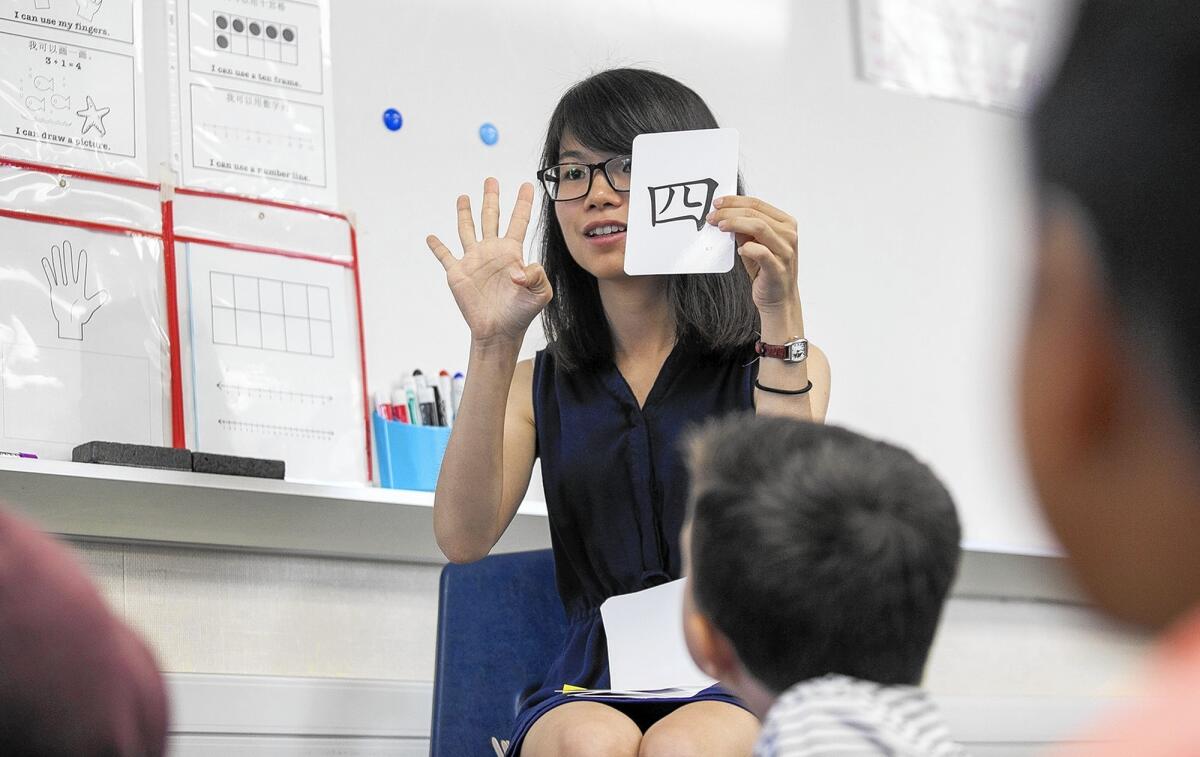Kindergartners start learning in Mandarin and English in dual-immersion program

- Share via
The Newport-Mesa school district has launched its first Mandarin Immersion Program at College Park Elementary School, in which kindergarten students will be instructed in English and Mandarin.
For the inaugural year, the program is starting with 20 students and one teacher, Vivian Lam, to guide them.
From 8 a.m. to 1:05 p.m., lessons for social studies, reading, language arts and science are taught in English while reading and language arts are taught in Mandarin. Math is taught in both English and Mandarin.
Before coming to the Costa Mesa school, Lam taught in a Mandarin immersion program at Broadway Elementary in the Los Angeles Unified School District.
“When you know more than one language, there are more opportunities available to you,” Lam said. “You could work at big companies, become a translator or even just help the people around you. And a lot of studies show that learning different languages at a young age will expand students’ cognitive abilities.”
On the first day of school at College Park, Lam showed her students a map of the world and pointed out all the countries they would be able to communicate with as Mandarin and English speakers.
Lam’s class also has children who use Spanish at home.
“Some of these students will become tri-lingual and they’ll be able to communicate with 75 percent of the world,” College Park Principal Julie McCormick said. “I’m a huge advocate for foreign language acquisition, especially for the younger ages.”
McCormick began recruiting families and students for the program in February, attending parent information nights at various preschools in the district.
The program was open to all incoming kindergartners within Newport-Mesa, whether they were English language learners or English-only speakers.
Many of the parents who showed interest in Mandarin Immersion were those who speak Spanish at home, McCormick said, including Costa Mesa resident Fatima Villegas.
While volunteering in the class, she also takes notes on what Lam is teaching. Villegas even has a Mandarin phrase book at home.
“I bought the book for myself,” she said with a laugh. “I want to be able to use [this language] with my son at home. When he comes home from school, he’s so excited to teach me and his older sister the words he learned that day. It’s amazing how fast he’s picked it up.”
For this first year of learning Mandarin, the class will focus on building vocabulary and listening skills.
“This is the time to teach them different words,” Lam said. “Then when they keep using them, by the end of first and second grade they’ll begin to develop some fluency.”
During their class on Thursday, Lam reviewed numbers with the kindergartners using flashcards with Mandarin characters on them.
She picked names out of a jar and each student she called on had to say what number the character was in Mandarin. The class applauded each time one of their peers got the character correct.
By now, the students have learned numbers one through 10 and around 20 other vocabulary words, Lam said.
College Park plans to have a first-grade and kindergarten class in the Mandarin Immersion Program next year. Each year, the program will keep advancing to the next grade level until it hits the sixth grade.
But their Mandarin learning will not end there.
“We’re always thinking about what we can do at the elementary level to feed into the high school level,” the district’s Executive Director of Elementary Education Kurt Suhr said. “A program at College Park would feed really nicely into the Mandarin classes offered in Costa Mesa High School.”
Also new this year is Whittier Elementary School’s Spanish Dual Language Program. Their program currently has two kindergarten classes, each with 20 students, who are learning language arts, math, social studies and science in both Spanish and English.
The school is using a 50/50 model, where students are being instructed in Spanish during one half of the day and English during the other.